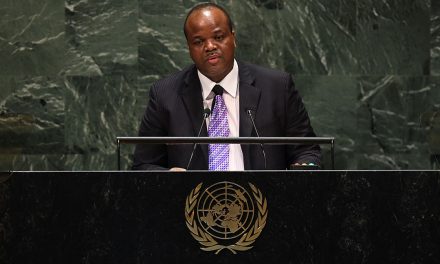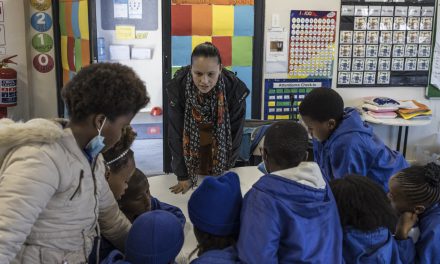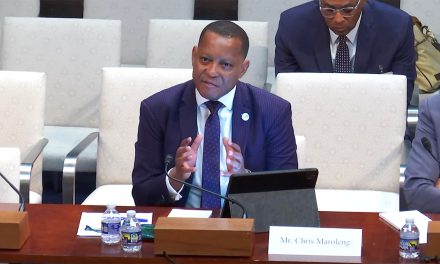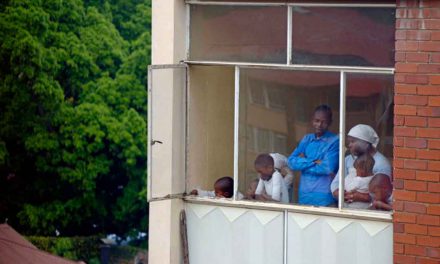For more than a decade, poor energy reliability in South Africa has had a crippling effect on the country’s economic development. According to a report by the Council for Scientific and Industrial Research (CSIR), South Africa experienced 859 hours of rolling blackouts in 2020 alone, equivalent to 10% of the year spent in darkness. Eskom is indebted to the tune of R440 billion. This is equivalent to almost half of the country’s annual budget.
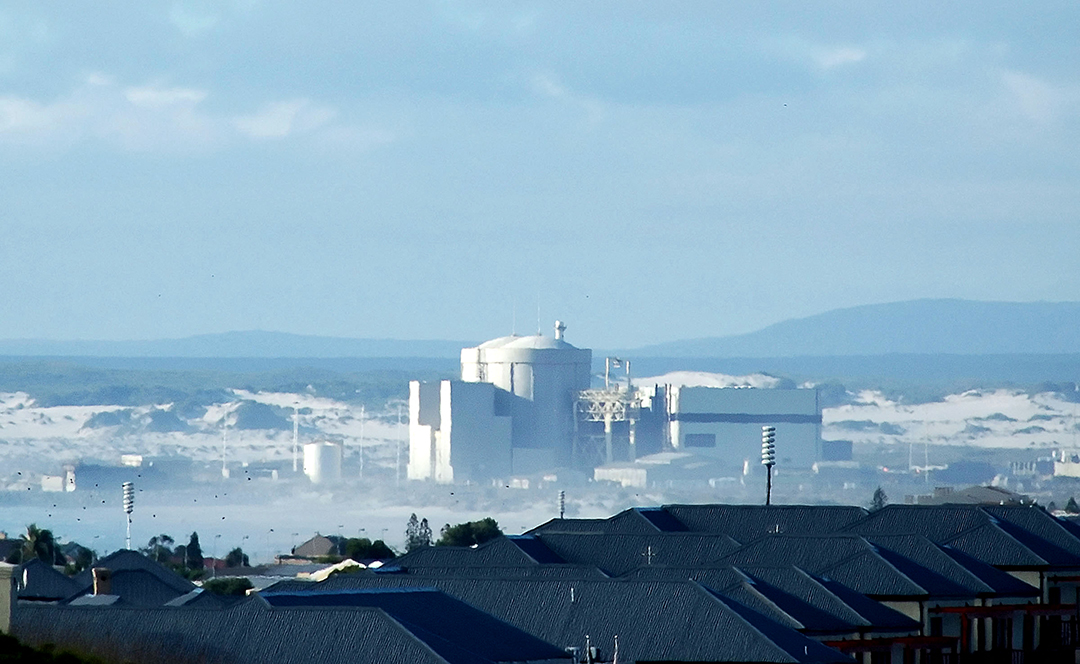
Koeberg nuclear power station. Photo: Rodger Bosch/AFP
The debt servicing costs of this amount alone, in addition to the now-perennial electricity supply gap, remains perhaps the single largest threat to the South African economy. In the 2022 budget, R21.9 billion was allocated to bailing Eskom out (again). The electricity demand-supply gap is estimated at between 4,000MW and 6,000MW. A further 6,800MW are at risk due to a lack of sufficient historical maintenance. In April 2022 unplanned outages of 15,000MW occurred. Recent economic analysis shows that reliable surplus supply is correlated with economic growth. In other words, growth-enhancing investment is unlikely to be forthcoming until South Africa credibly demonstrates that its supply shortages will be addressed.
Despite South Africa’s commitments under the Paris Agreement to lower its carbon emissions, the government continues to prioritise investment in coal-powered energy stations while failing to capitalise on recent advancements made in wind, solar, and nuclear energy technologies. It is crucial that South Africa’s 2019 Integrated Resource Plan (IRP) and Renewable Independent Power Producer Programme (REIPPP) be reviewed and expanded respectively to harness the potential of these advancements to provide greater long-run economic and environmental benefits for the country. Data from the CSIR has demonstrated that “South Africa has perfect conditions to introduce a very large amount of variable renewables into the electricity system in a cost-effective way”. The remainder could be supplemented by open-cycle gas turbines, essentially removing coal requirements in the medium to long term.
South Africa remains heavily reliant, however, on an ageing fleet of coal-power stations despite being the twelfth largest emitter of carbon dioxide (CO2) in the world. The country’s generation capacity is roughly 58,000MW, of which 38,000MW comes from 15 coal plants, which makes up about 80% of the country’s energy mix, followed by renewables at 16% and nuclear at 5%. The energy generation capacity shortfall will likely continue to grow in the short term, increasing the risk of load-shedding.
At last year’s COP26 climate summit, a deal was struck for South Africa to receive $8,5 billion in funding from the United States, the United Kingdom, and European Union member states to assist in the transition from coal towards a low-carbon economy. However, Mineral Resources and Energy (DMRE) minister Gwede Mantashe has continuously cautioned against the transition, citing energy supply issues and SA’s high unemployment rate. Eskom plans to decommission between 8,000 and 12,000MW worth of coal capacity from its fleet by 2031. However, decommissioning is already well behind schedule. Meanwhile, the IRP outlines government’s intension to build 1,500MW of new coal capacity by 2030, which is difficult to understand.
Building new coal plants will increase both CO2 emissions and long-term energy costs, especially given the rate at which the cost of renewables has fallen in the last decade. Despite the calls for a green economic recovery from the pandemic, environmental concerns have received lower priority compared to economic and political considerations. Based on the scientific evidence provided by the latest Intergovernmental Panel on Climate Change (IPCC) report, climate change impacts have started occurring at a rapid speed and temperatures are increasing at twice the global rate in sub-Saharan Africa. The burning of fossil fuels, especially coal, will increase the levels of global carbon emissions, leading to a dangerous interference with the climate system. Coal can therefore only be an interim solution to the energy crisis.
Short term measures that focus only on immediate economic recovery without addressing long-term sustainability issues will have dire impacts on the climate and the economy. It is important that South Africa consider alternatives that will enhance economic growth while combating climate change. One alternative is to increase investment in nuclear energy production, given some of the recent advancements in addressing long-running safety and environmental concerns associated with the industry.
Since the early 2000s there has been a growing number of research studies on nuclear power and significant technological advancements within the sector. A recent study by the International Atomic Energy Agency (IAEA) argues that nuclear power can contribute substantively to the decarbonisation of electricity supply, helping achieve climate goals by 2050. Nuclear power is a relatively clean source of energy that is often left out of clean-energy discussions. It is also the second largest source of low-carbon electricity in the world and removes harmful air pollutants. Steven Pinker notes in his recent book, Rationality, that burning coal kills more people across the world in a day than nuclear power has killed in the entire history of its existence.
South Africa operates a two unit-reactor nuclear power plant (Koeberg) in Cape Town. While the expansion of nuclear energy has been advocated by Eskom as a means to assist South Africa to achieve its climate change ambitions under the Paris Agreement, plans to extend the operation of Koeberg (which was expected to be retired in 2024) might not be viable. Koeberg has been in operation since 1984 (a time when nuclear was considered a low-cost option for South Africa) and is built on old technology which lacks modern safety features, posing a threat to those living nearby. Operational incidents at the station earlier this year brought to the fore discussions about Koeberg’s current safety rankings and the future of South Africa’s nuclear energy production capacity.
Small Modular Reactors (SMRs) offer a better alternative to large power stations like Koeberg. They are smaller scale projects that can play a vital role in helping South Africa transition to a low carbon economy by replacing ageing coal plants and extending the nuclear market. SMR development includes land and marine-based water-cooled reactors, high-temperature gas-cooled SMRs, fast-neutron-spectrum reactors, molten-salt reactors, and, most recently, micro-reactors. SMRs are a cost-effective energy production option that require less space than their older counterparts. They produce, on average, one-third of the generating capacity of traditional nuclear power reactors. Unlike power plants, which take 5-16 years to build and are subject to unproductive rent-seeking, SMRs have a shorter construction time of 3-5 years.
The IRP recognises the vital role nuclear energy production can play in South Africa’s energy mix and proposes a nuclear build programme of up to 2,500MW. However, the IRP must be reviewed taking into account the risks associated with extending Koeberg, such as safety, transmission losses and rent-seeking, and instead consider the potential of new nuclear technological developments such as SMRs.
SMRs are also well-suited for inclusion in the Renewable Energy Independent Power Producer Programme (REIPPP) – the government’s plan to bring additional megawatts onto the country’s electricity system through private-sector investment in largely renewable energy sources. The president recently announced that the ceiling for such production will be lifted from 1MW to 100MW. SMRs are relatively small and low-risk projects and their construction timeframes are well within the prescribed REIPPP timeframes. Adding them to the energy supply mix would help to decrease the chances of load-shedding during high demand times and reduce load on other energy sources. The REIPP programme has been delayed with not one project in progress despite the R200 billion of investments mobilised.
Both solar and wind energy are also critical to diversifying the power mix, ensuring energy security, and lowering GHG emissions. South Africa’s energy requirement can be met if wind, solar and SMRs are strategically positioned and planned out. Nuclear projects are likely to receive widespread criticism. Public debate, awareness-raising and consultation are therefore needed to develop support from the population and to address public fears related to safety and potentially negative environmental effects.
- An earlier version of this article first appeared in the Mail & Guardian, titled “Nuclear is South Africa’s energy solution”.
[activecampaign form=1]
Leleti Maluleke is a Researcher for our Human Security and Climate Change programme. She completed her Bachelor of Political Science in Political Studies in 2017, and her Honours in International Relations in 2018 at the University of Pretoria. She started her career at International SOS in the Security Services department as a Political Risk and Security Intern. Socially, her countries of interests include Mozambique, Zimbabwe, Zambia and Malawi.


